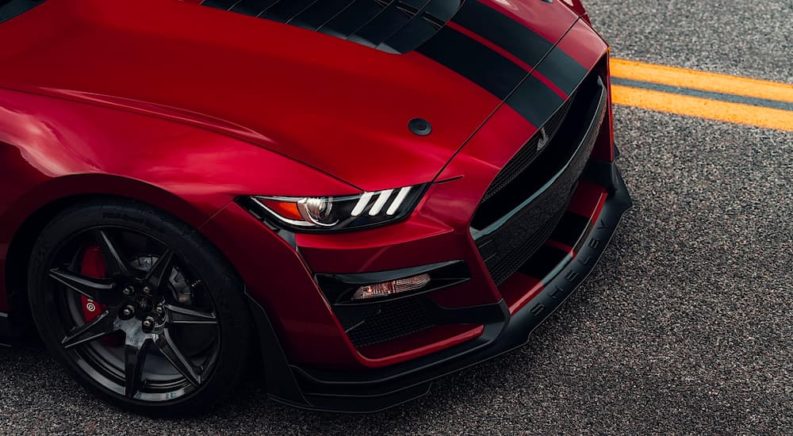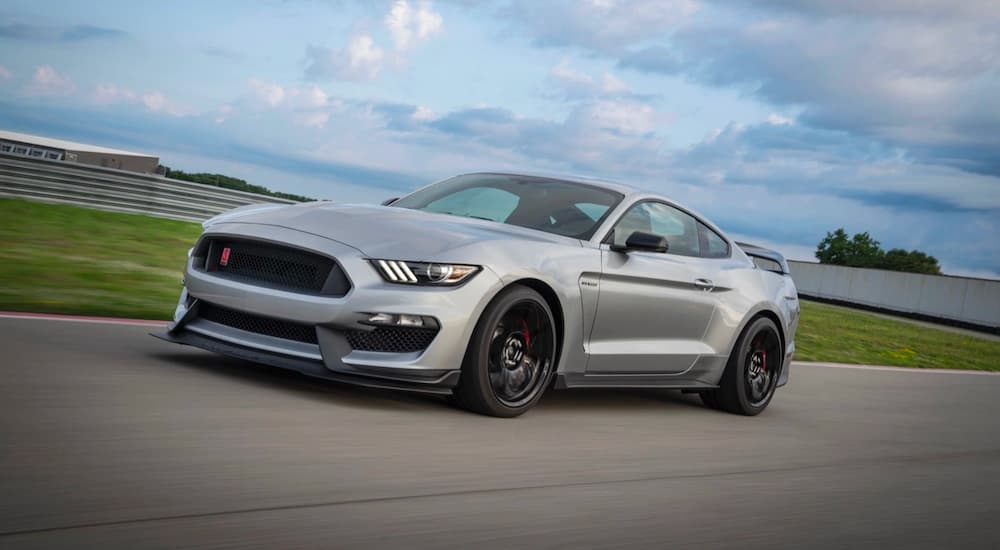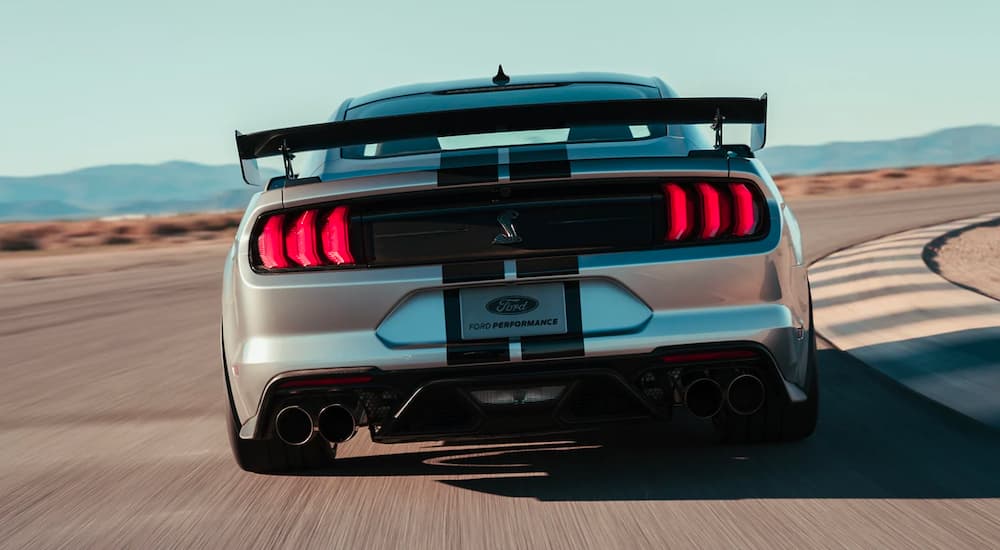Truth be told, you probably don’t need to know who Carroll Shelby was in order to appreciate the Shelby GT500. You don’t necessarily have to know the backstory of how Shelby and Ford came together in order to search for a Shelby GT500 for sale. You don’t even need to know about the Ford racing in the 24 Hours of Le Mans or Shelby’s Mustangs and the Trans-Am series of the late 1960s. But all of these facts and trivia are part of the amazing journey that Ford, the Mustang, Carroll Shelby, and a whole lot of performance engineering took to create the Shelby GT500.
With 2022 being the last year of production for this inimitable vehicle––at least for the foreseeable future––perhaps the time is right to look back on this journey. After all, the 2022 Ford Mustang Shelby GT500 may go 0-60 mph in just 3.4 seconds, but the development of a legend takes a little bit longer. Let’s take a look at how the GT500 managed to get its wings and why many drivers are hopeful that we’ll see this car on the road forever.
From Pony to Racehorse
April 17, 1964, is the official birthdate of the American legend known as the Ford Mustang. From its appearance in Bond films to its debut at the World’s Fair, the Mustang had quite the birthday celebration. But Ford Division General Manager Lee Iacocca was concerned that the Mustang wasn’t as performance-oriented as he and the Ford Division Total Performance marketing program had hoped. As a result, he called upon his good friend Carroll Shelby to help him remedy this.
Shelby already had plenty of clout in the performance world. Not only was he a winning driver in the famous 24 Hours of Le Mans endurance race and the creator of the iconic Shelby Cobra roadster, but he had recently worked with Ford to develop the GT40 race car. Given that the GT40 was dominating a racing world populated by Porsches and Ferraris, Shelby seemed an ideal choice to put a little more zest into the Mustang.
The first collaboration was the Shelby GT350, which competed in the Sports Car Club of America’s B Production Class. This class includes some ferocious vehicles, including the Corvette Stingray, Jaguar XKE, and Sunbeam Tiger, and yet the Shelby Mustang won the 1965 B Production National Championship without breaking a sweat. One could say Shelby had accomplished his mission, but he was just getting started.
The Birth and Anti-Climax of the GT500
The GT500 debuted in 1967. It might have appeared earlier, but Shelby wanted to make sure the Mustang was large enough to hold a 428 cubic inch big-block V8 engine. This powerful motor was the same size as the engine in the GT40 race car and supplied the original GT500 with an incredible 355 hp and 420 lb-ft of torque. However, while it may seem that things were just getting started for this legendary car, there were a few complications along the way.
First, Ford Motor Company took over the production of Shelby vehicles in 1968. While many would consider this move as an opportunity for infinite possibilities to come to life, it more or less squashed the GT500, which was seen as too performance-oriented. The Shelby American racing team retired from the Trans-Am series in 1969. Finally, Carroll Shelby announced his retirement in January 1970, which would be the last year of production for the GT500.
The 1970s and 1980s were a rough time to be an automobile manufacturer, given the oil embargo and the resulting need for vehicles with lower fuel consumption. Lee Iacocca left Ford in 1978, and American opinions about vehicles changed. The Ford Mustang was still around, and people were still driving and collecting them, but a certain spark was gone and there was no interest in race-ready monsters like the GT500.
Thankfully, things changed, and in 2005, Shelby and Ford came together once again with a high-performance Mustang concept. The limited-edition 2006 Shelby GT-H 40th anniversary car left the public wanting more; thus, the Ford Shelby GT500 appeared again in 2007.
The Modern GT500
Obviously, a lot of things had changed in the almost forty years between 1970 and 2007. While American drivers still enjoyed going as fast as possible in a stylish, attractive vehicle, “fast” was now “even faster,” and “big” had become “even bigger.” The 2007 collaboration between Shelby Automobiles and Ford Special Vehicle Team actually resulted in two GT500 models: the base version from Ford and the upgraded Super Snake from Shelby.
The reviews were glowing, as the newest version of the GT500 had road manners, track performance, looked super-cool, and was affordable to boot. Plus, the 5.4-liter V8 engine provided a massive 500 hp and 480 lb-ft of torque without losing its street-legal status. In fact, you could purchase the coupe version or go for a convertible option if you so choose.
The Ford/Shelby partnership has continued, even after Carroll Shelby’s passing in 2012. Recent projects include the Shelby Raptor, Shelby F-150 Super Snake, and Shelby F-250 Super Baja, but the GT500 has continued to capture the imagination of pony car aficionados all along the way.
Powered by a 5.2L supercharged cross-plane crank V8 engine known as the “Predator,” the 2022 Shelby GT500 provides 760 hp and 625 lb-ft of torque. Equipped with a Tremec seven-speed dual-clutch transmission, a Torsen limited-slip rear axle, a MagneRide damping system, and Brembo brakes in the front and rear, today’s Shelby GT500 is ready to roll…quickly. It’s even been outfitted with track-only features, such as electric line lock and digital Track Apps to help drivers keep track of their fastest times.
In essence, what Ford claims will be the last Shelby GT500 collaboration for the foreseeable future is exactly what Lee Iacocca and Carroll Shelby dreamed of creating way back in 1965. It’s even been track validated by Ford Racing.
The Future of Performance
It’s hard to say exactly what the future holds for performance cars. On the one hand, Ford doesn’t really produce cars anymore. On the other hand, the manufacturer has expanded the Mustang nameplate to the Mach-E SUV, an electric vehicle that bears little resemblance to its namesake. Performance vehicles may guzzle less gas than they did in the past, but they’re still not exactly economical, and with emissions and environmental concerns at the forefront of many manufacturers’ minds right now, it’s easy to see why the GT500 has been shelved.
However, there are still Corvettes and Ferraris in this world, so it stands to reason that the more affordable performance options like the Shelby Mustang still stand a chance. We also live in a world filled with technology, which means an electrified performance pony car isn’t entirely out of the picture. At the end of the day, we can’t pretend to know what automotive manufacturers have up their sleeves. But we can recognize when a car has become a legend. In the case of the Shelby GT500, it’s clear that, although it has only been produced in limited numbers, people will continue to seek out Shelby GT500 models for sale for many years to come.






